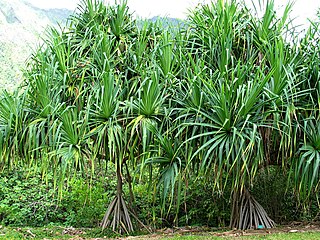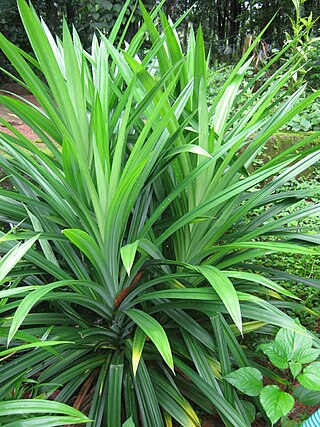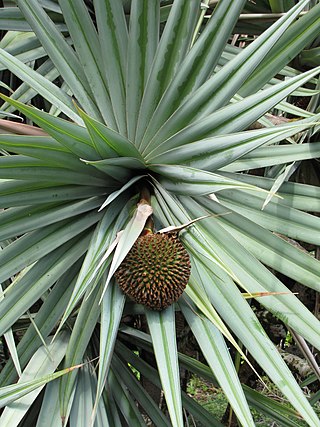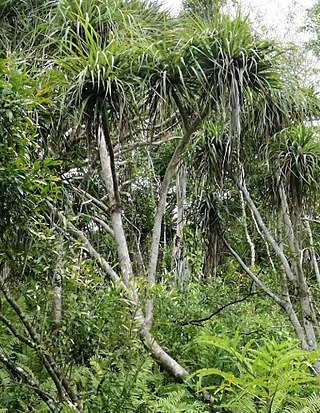
Pandanales, the pandans or screw-pines, is an order of flowering plants placed in the monocot clade in the Angiosperm Phylogeny Group and Angiosperm Phylogeny Web systems. Within the monocots Pandanales are grouped in the lilioid monocots where they are in a sister group relationship with the Dioscoreales. Historically the order has consisted of a number of different families in different systems but modern classification of the order is based primarily on molecular phylogenetics despite diverse morphology which previously placed many of the families in other groupings based on apparent similarity. Members of the order have a subtropical distribution and includes trees, shrubs, and vines as well as herbaceous plants. The order consists of 5 families, 36 genera and about 1,610 species.

Pandanus is a genus of monocots with about 578 accepted species. They are palm-like, dioecious trees and shrubs native to the Old World tropics and subtropics. Common names include pandan, screw palm and screw pine. They are classified in the order Pandanales, family Pandanaceae.

Pandanus tectorius is a species of Pandanus (screwpine) that is native to Malesia, Papuasia, eastern Australia, and the Pacific Islands. It grows in the coastal lowlands typically near the edge of the ocean. Common names in English include thatch screwpine, Tahitian screwpine, hala tree and pandanus. The fruit is edible and sometimes known as hala fruit.

Pandanaceae is a family of flowering plants native to the tropics and subtropics of the Old World, from West Africa to the Pacific. It contains 982 known species in five genera, of which the type genus, Pandanus, is the most important, with species like Pandanus amaryllifolius and karuka being important sources of food. The family likely originated during the Late Cretaceous.

Pandanus amaryllifolius is a tropical plant in the Pandanus (screwpine) genus, which is commonly known as pandan. It has fragrant leaves which are used widely for flavouring in the cuisines of Southeast Asia. It is also featured in some South Asian cuisines and in Hainanese cuisine from China.

Pandanus utilis, the common screwpine is, despite its name, a monocot and not a pine. It is native to Madagascar and naturalised in Mauritius and the Seychelles.
The wildlife of Mauritius consists of its flora and fauna. Mauritius is located in the Indian Ocean to the east of Madagascar. Due to its isolation, it has a relatively low diversity of wildlife; however, a high proportion of these are endemic species occurring nowhere else in the world. Many of these are now threatened with extinction because of human activities including habitat destruction and the introduction of non-native species. Some have already become extinct, most famously the dodo which disappeared in the 17th century.

Pandanus balfourii, also known as Vakwa bordmer, is a species of plant in the family Pandanaceae, one of four Pandanus species that are endemic to the Seychelles.

Pandanus palustris is a species of plant in the family Pandanaceae, endemic to Mauritius. It was once common in marshes and in the wetter highlands of Mauritius, but is now threatened by habitat loss.
Pandanus papenooensis is a species of plant in the family Pandanaceae. It is a tree endemic to the island of Tahiti, in the Society Islands of French Polynesia.
Pandanus temehaniensis is a species of plant in the family Pandanaceae. It is a tree endemic to the island of Raiatea, in the Society Islands of French Polynesia.
Harold St. John was a professor of botany at the University of Hawaiʻi at Mānoa from 1929 to 1958. A prolific specialist in field botany and systematics, he is credited with naming about 500 new species of Pandanus, along with many other species, especially in the Pacific Islands.
Trissodoris honorariella, the pandanus leaf perforator or pandanus hole-cutter moth, is a small cosmet moth species. It belongs to subfamily Cosmopteriginae and is the type species of the genus Trissodoris. Baron Thomas Walsingham in 1907 had specimens from both ends of the species' range – New Guinea and Pitcairn Island – which he described as separate species Stagmatophora honorariella and S. quadrifasciata in the same work. But his mistake was soon recognized, and when Edward Meyrick established the genus Trissodoris in 1914, he chose the former name to be valid.

Pandanus odorifer is an aromatic monocot species of plant in the family Pandanaceae, native to Polynesia, Australia, South Asia, and the Philippines, and is also found wild in southern India and Burma. It is commonly known as fragrant screw-pine.

Pandanus vandermeeschii is a species of plant in the family Pandanaceae. It is endemic to the coastal areas of Mauritius.

Pandanus iceryi ("Vacoas") is a species of plant in the family Pandanaceae. It is endemic to Mauritius.

Pandanus heterocarpus is a species of plant in the family Pandanaceae. It is commonly called the "Rodrigues screwpine", known locally as "vacoa parasol" or "vacoa cale rouge". It is endemic to the island of Rodrigues.

Pandanus tenuifolius is a species of plant in the family Pandanaceae. It is endemic to the island of Rodrigues.

Pandanus dubius, commonly known as bakong or knob-fruited screwpine, is a species of Pandanus (screwpine) native to Island Southeast Asia, New Guinea, and the Western Pacific islands, and possibly also to the Andaman and Nicobar Islands.
Pandanus brosimos, the wild karuka, is a species of tree in the family Pandanaceae, endemic to New Guinea. Along with Pandanus julianettii, it is widely harvested in New Guinea as a traditional food source. Many local ethnic groups make use of pandanus languages when harvesting the nuts.













